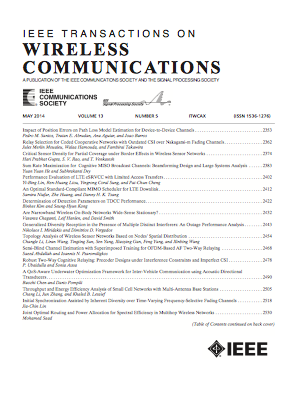避免捷径:通过单源域泛化增强信道鲁棒特定发射器识别
IF 10.7
1区 计算机科学
Q1 ENGINEERING, ELECTRICAL & ELECTRONIC
引用次数: 0
摘要
特定发射器识别技术通过从接收信号中提取射频指纹,成为无线设备物理层识别的一种很有前途的技术。最近,由于基于深度学习(DL)的SEI方法在跨通道条件下表现出较弱的鲁棒性,通道鲁棒性SEI引起了越来越多的关注。为了解决这些限制,我们提出了一种基于单源域泛化(SDG)的新型通道鲁棒SEI框架。首先,我们从深度学习中的“捷径学习”现象的角度分析了现有SEI方法的弱鲁棒性。快速学习可能会导致传统的SEI方法优先考虑信号样本中易于挖掘的瞬态信道特征,而不是关注由硬件差异产生的更稳定的射频指纹。接下来,我们从SDG的角度,勾勒出整改SEI中捷径学习的优化目标。受此优化目标的启发,我们提出了一种通道鲁棒SEI方法。该方法包括通过多尺度卷积注意网络(MSCAN)进行特征嵌入、使用随机叠加增强(ROA)生成多个虚拟域的域扩展以及基于对比学习的双对齐策略。具体来说,监督对比学习用于分类对齐,而监督对比对抗学习用于领域对齐。这种双对齐策略可以优化MSCAN学习判别和域不变特征表示,从而增强SEI的鲁棒性。在ORACLE数据集和WiSig数据集上的仿真实验证明了我们的方法与目前最先进的技术相比的优越性。代码可以从GitHub (https://github.com/BeechburgPieStar/SDG-for-Channel-Robust-SEI)下载。本文章由计算机程序翻译,如有差异,请以英文原文为准。
Avoiding Shortcuts: Enhancing Channel-Robust Specific Emitter Identification via Single-Source Domain Generalization
By extracting radio frequency (RF) fingerprints from received signals, specific emitter identification (SEI) becomes a promising technique for physical layer identification of wireless devices. Recently, channel-robust SEI has attracted increasing attention due to the weak robustness exhibited by deep learning (DL)-based SEI methods in cross-channel conditions. To address these limitations, we propose a novel channel-robust SEI framework based on single-source domain generalization (SDG). Initially, we analyze the weak robustness of existing SEI methods from the perspective of the “shortcut learning” phenomenon in DL. Shortcut learning may lead traditional SEI methods to prioritize easily-mined, yet transient, channel characteristics in signal samples, rather than focusing on the more stable RF fingerprints derived from hardware differences. Next, from the perspective of SDG, we outline the optimization goal to rectify the shortcut learning in SEI. Inspired by this optimization goal, we then propose a channel-robust SEI method. This method consists of feature embedding through a multi-scale convolutional attention network (MSCAN), domain expansion using random overlay augmentation (ROA) to generate multiple virtual domains, and dual alignment strategy based on contrastive learning. Specifically, supervised contrastive learning is implemented for category-wise alignment, while supervised contrastive adversarial learning is utilized for domain-wise alignment. This dual alignment strategy can optimize the MSCAN to learn discriminative and domain-invariant feature representations, thereby enhancing the robustness of SEI. Simulation experiments on the ORACLE dataset and the WiSig dataset have demonstrated the superiority of our method compared to state-of-the-art techniques. The codes can be downloaded from GitHub (https://github.com/BeechburgPieStar/SDG-for-Channel-Robust-SEI ).
求助全文
通过发布文献求助,成功后即可免费获取论文全文。
去求助
来源期刊
CiteScore
18.60
自引率
10.60%
发文量
708
审稿时长
5.6 months
期刊介绍:
The IEEE Transactions on Wireless Communications is a prestigious publication that showcases cutting-edge advancements in wireless communications. It welcomes both theoretical and practical contributions in various areas. The scope of the Transactions encompasses a wide range of topics, including modulation and coding, detection and estimation, propagation and channel characterization, and diversity techniques. The journal also emphasizes the physical and link layer communication aspects of network architectures and protocols.
The journal is open to papers on specific topics or non-traditional topics related to specific application areas. This includes simulation tools and methodologies, orthogonal frequency division multiplexing, MIMO systems, and wireless over optical technologies.
Overall, the IEEE Transactions on Wireless Communications serves as a platform for high-quality manuscripts that push the boundaries of wireless communications and contribute to advancements in the field.

 求助内容:
求助内容: 应助结果提醒方式:
应助结果提醒方式:


